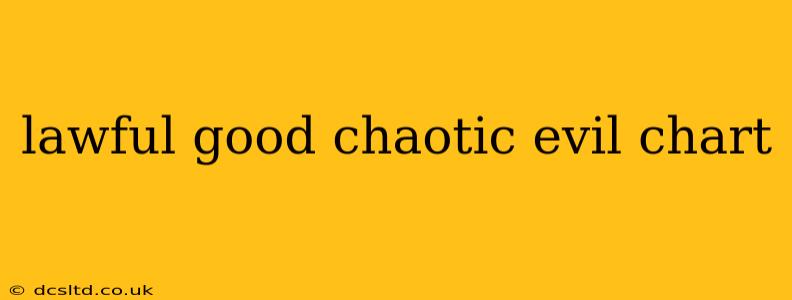The Lawful Good, Chaotic Evil alignment chart, a cornerstone of Dungeons & Dragons (D&D) and many other fantasy role-playing games, provides a framework for understanding character motivations and morality. It's not just a simple good versus evil dichotomy; it explores the complex interplay between personal freedom and societal order, resulting in nine distinct alignments. This guide delves into the core concepts of Lawful Good and Chaotic Evil, exploring their nuances and providing examples to help you better understand this fascinating system.
What is the Alignment Chart?
The alignment chart is a two-axis system, with one axis representing morality (good, neutral, evil) and the other representing behavior (lawful, neutral, chaotic). Each axis has three points, resulting in nine possible combinations. These alignments are not absolute moral judgments but rather reflect a character's typical approach to the world. A character's alignment can change over time based on their experiences and decisions.
Understanding Lawful Good
Lawful Good characters are guided by a strong moral compass and a respect for rules and order. They strive to uphold justice and do what is right, even when it's difficult. They believe in the importance of laws and institutions, but not blindly; they will challenge unjust laws and fight for positive change within the system.
Key Traits of Lawful Good Characters:
- Uphold Justice: They believe in fairness and strive to ensure that everyone is treated equally under the law.
- Respect Authority: They generally respect authority figures, but not unquestioningly. They will challenge authority if it acts unjustly.
- Honorable and Trustworthy: They are known for their integrity and can be relied upon to keep their word.
- Compassionate and Empathetic: They care deeply about others and strive to help those in need.
Examples of Lawful Good Characters:
- A paladin sworn to uphold a sacred oath. Their actions are guided by their religious beliefs and a commitment to justice.
- A judge dedicated to fairness and upholding the law. They strive to ensure that everyone receives a fair trial.
- A diligent police officer committed to protecting the innocent. They follow procedures and regulations while maintaining a strong moral code.
Understanding Chaotic Evil
Chaotic Evil characters are driven by self-interest and a disregard for the well-being of others. They act impulsively and often without regard for the consequences of their actions. They may be motivated by greed, power, or a simple desire to cause chaos and destruction. They see rules and laws as obstacles to overcome, rather than guidelines to follow.
Key Traits of Chaotic Evil Characters:
- Self-Serving and Ruthless: Their primary concern is their own advancement, even at the expense of others.
- Disregard for Rules and Order: They view rules as mere suggestions to be ignored or exploited.
- Cruel and Violent: They are often violent and enjoy inflicting suffering on others.
- Unpredictable and Impulsive: Their actions are driven by their desires, without much forethought.
Examples of Chaotic Evil Characters:
- A ruthless warlord who conquers lands and enslaves peoples. Their actions are solely motivated by a desire for power and wealth.
- A manipulative sorcerer who uses dark magic to achieve their goals. They care little for the consequences of their spells and the suffering they cause.
- A sadistic bandit who terrorizes travelers for pleasure. Their enjoyment comes from inflicting pain and suffering.
The Spectrum of Alignment: Where Do Other Alignments Fit?
The Lawful Good/Chaotic Evil spectrum represents only two points on a larger scale. The other seven alignments occupy positions in between, representing varying degrees of lawful/chaotic and good/evil tendencies. For example:
- Neutral Good: Acts to help others, but isn't necessarily bound by laws.
- Lawful Neutral: Follows the rules and laws, but doesn't necessarily do good.
- Chaotic Good: Acts according to their conscience, even if it breaks the law.
- True Neutral: Unbiased; acts according to self-interest without a strong moral leaning.
- Lawful Evil: Uses laws and order to further their evil goals.
- Neutral Evil: Acts in their self-interest, often causing harm without necessarily being chaotic.
- Chaotic Neutral: Acts according to whim, but neither good nor evil.
How Alignment Affects Gameplay
Understanding the alignment system adds depth and complexity to roleplaying. A character's alignment can influence their choices, relationships with other characters, and even their abilities (as in the case of paladins, whose power is tied to their alignment). It's a tool for creating richer, more believable characters and engaging storylines.
This exploration of the alignment chart, specifically focusing on the contrasting nature of Lawful Good and Chaotic Evil, offers a deeper understanding of the moral complexities within the D&D universe and beyond. The system encourages players to consider their character's motivations, actions, and the consequences of those actions within the larger world.
